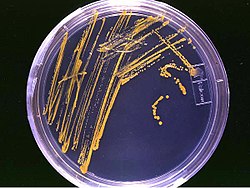Growth medium
liquid or gel used for the growth of microorganisms or cells
A growth medium or culture medium is a solid or liquid containing nutrients. It is designed to support the growth of microorganisms or cells,[1] or small plants like moss.[2] There are different types of media for growing different types of cells.[3]

There are a wide range of growth media used in biology. Some of the basic types are:
- Undefined versus defined media: with defined media we know exactly what chemicals are in them.
- Selective media: for example, a medium with an antibiotic added. The only things which grow are those resistant to the antibiotic.
- Differential media: these distinguish one microorganism type from another growing on the same plate.
- Transport media: these have just enough to let organisms survive.
- Enriched media: contain extra amino acids and other building blocks. Used to harvest a wide range of organisms from a particular source.
References
change- ↑ Madigan M. & Martinko J. (eds) 2005. Brock Biology of Microorganisms (11th ed.). Prentice Hall. ISBN 0-13-144329-1.
{{cite book}}: CS1 maint: numeric names: authors list (link) - ↑ Hadeler, Birgit; Scholz, Sirkka & Reski, Ralf 1995. Gelrite and agar differently influence cytokinin-sensitivity of a moss. Journal of Plant Physiology 146, 369–371.
- ↑ Ryan K.J. & Ray C.G. (eds) 2004 (2004). Sherris Medical Microbiology. 4th ed, McGraw Hill. ISBN 0-8385-8529-9.
{{cite book}}: CS1 maint: numeric names: authors list (link)